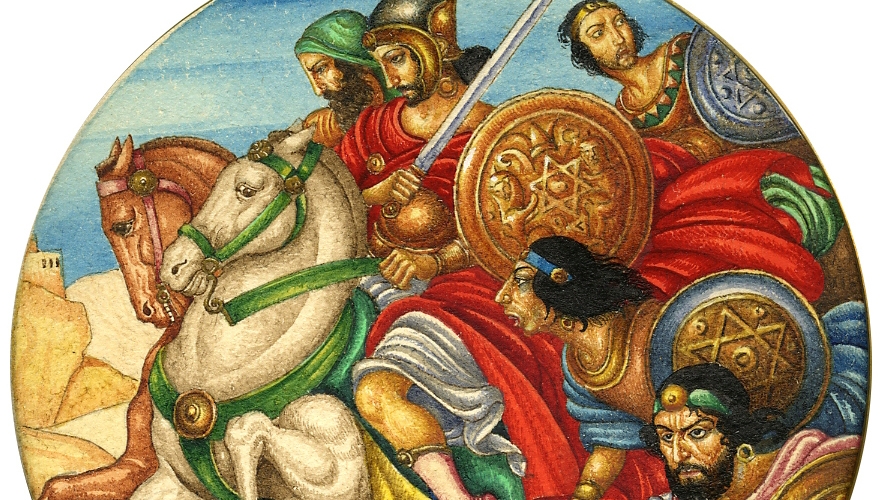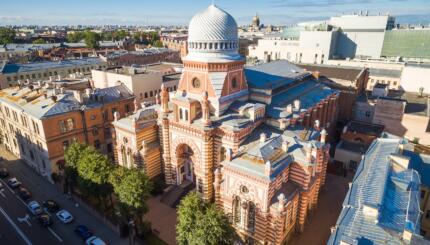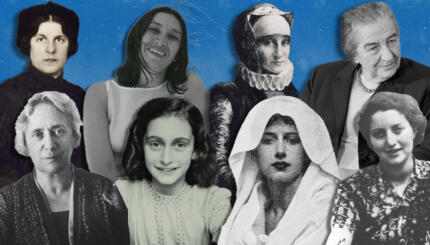During World War II, readers of Life, Time, Esquire, and other American magazines enjoyed the vivid anti-Nazi cartoons of Arthur Szyk (1894-1951), a Polish-born Jewish artist and illustrator. Szyk’s witty and dramatic style packed a fiery political punch. Szyk was a fierce advocate for justice.
One of his wartime cartoons was so liberal that it proved too hot for any publisher to handle. Veering away from his usual Axis targets, Szyk depicted two GIs, one white and one black, escorting German prisoners. The white soldier asks his comrade, “And what would you do with Hitler?” The black soldier replies: “I would have made him a Negro and dropped him somewhere in the US!” Not one American magazine or newspaper printed it.
A soldier in the Polish army during World War I, Szyk fell prisoner to the Germans but received lenient treatment because his captors admired his artistic talents. After the war, Szyk traveled to Ukraine, where he witnessed pogroms that devastated Jewish communities. Deeply moved, Szyk returned throughout his career to Jewish themes and struggles for freedom.
In 1934, Szyk created a series of thirty-eight paintings depicting the American Revolution that were exhibited at the Paris World?s Fair. They caught the eye of visiting Polish officials, who purchased and presented them as a gift to President Franklin D. Roosevelt.

Help us keep Jewish knowledge accessible to millions of people around the world.
Your donation to My Jewish Learning fuels endless journeys of Jewish discovery. With your help, My Jewish Learning can continue to provide nonstop opportunities for learning, connection and growth.
Szyk’s most famous work was his illuminated Haggadah (1939), found to this day on Passover seder tables throughout the world. Although hailed by the Times of London as “among the most beautiful books that the hand of man has produced,” intimidated European publishers refused to print it, fearing that his graphic allusions to the Nazis might provoke German wrath. Finally, Szyk found an English publisher who agreed to publish the work if Szyk whittled down the anti-Nazi content to only two depictions of Hitler as the “wicked son.”
When the Nazis overran Poland in September 1939, Szyk was in London. He immediately began contributing illustrations to the war propaganda campaign. A colleague described Szyk’s political art as “powerful as a bomb, clear in conception, definite, and deadly in its execution.” The British authorities dispatched Szyk to the United States in 1940, hoping his work would sway American public opinion to join the struggle against Hitler.
Living in Connecticut, Szyk became the editorial cartoonist for the New York Post and contributed a steady stream of anti-Nazi cartoons and illustrations to major magazines. He also designed military badges and “Buy War Bonds” billboards. Szyk thought of himself as “Roosevelt’s soldier with a pen.” He wrote, “I consider myself as being on duty in my cartoons.” While he would have preferred to continue doing illuminated manuscripts and other forms of art, he observed, “We are not entitled to do the things we like today.” Eleanor Roosevelt once remarked, “This is a personal war of Szyk against Hitler, and I do not think that Mr. Szyk will lose this war!”
Szyk’s devotion to the Allied war effort was matched by his growing concern for Jews trapped in Nazi-occupied Europe. In 1941, Szyk joined forces with the Bergson Group, a band of Jewish activists who lobbied the Roosevelt Administration to rescue endangered Jews. After the war, the Bergsons rallied American public support for the Jewish underground’s revolt against the British in Palestine. Szyk’s dramatic illustrations were featured in the full-page advertisements in American newspapers.
Ben Hecht, who wrote the text for many of the Bergson group’s newspapers ads, called Szyk “our one-man art department”:
Arthur Szyk . . . worked for eight years without a pause. Nobody paid him anything and nobody thought of thanking him…Szyk’s art lent a nobility to the Irgun cause. His Hebrews under fire, under torture, exterminated in lime pits and bonfires . . . remained a people to be loved and admired. Their faces fleeing from massacre now, were tense and still beautiful. There was never slovenly despair or hysterical agony in Szyk’s dying Jews, but only courage and beauty. If there was ever an artist who believed that an hour of valor was better than a lifetime of furtiveness and cringe, it was Szyk.
Szyk died in 1951 at the age of 57. His life was indeed that “hour of valor” to which Ben Hecht alluded, an artist whose brush was truly his sword.
Chapters in American Jewish History are provided by the American Jewish Historical Society, collecting, preserving, fostering scholarship and providing access to the continuity of Jewish life in America for more than 350 years (and counting). Visit www.ajhs.org.



